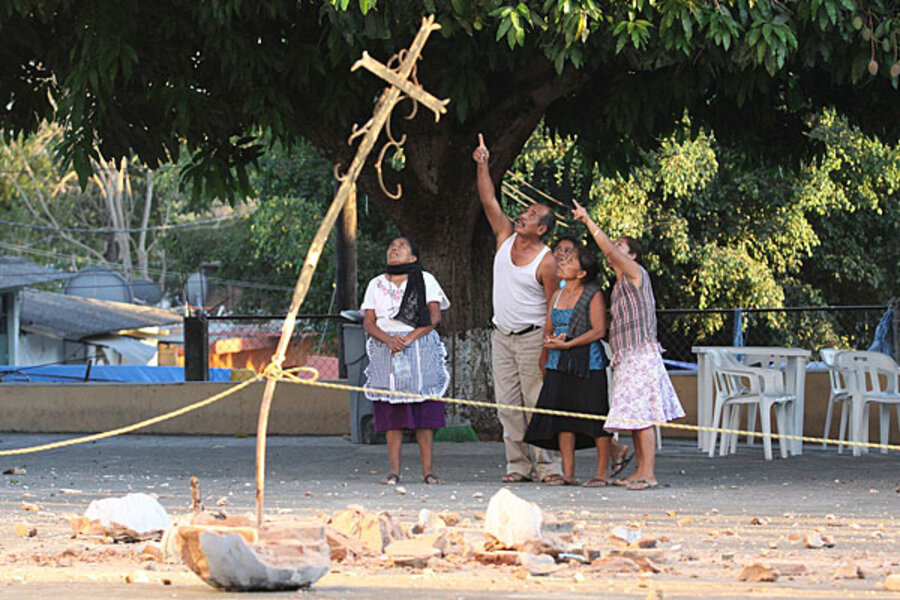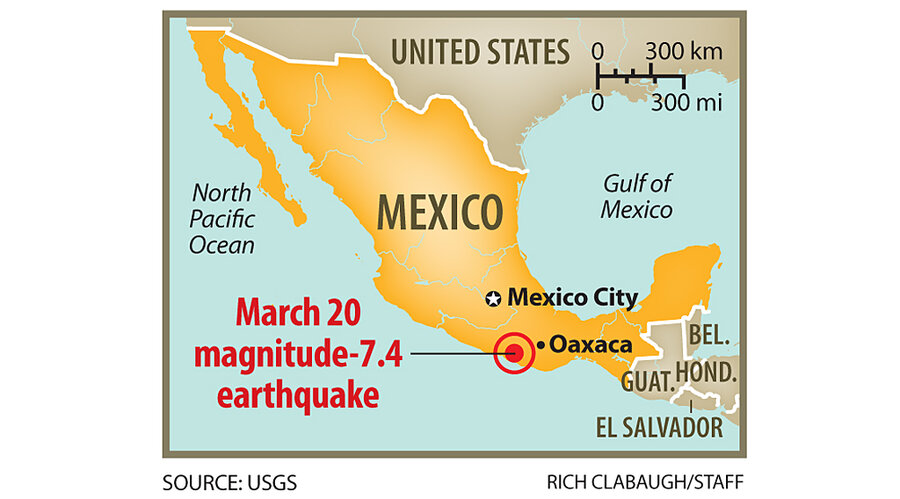Earthquake in Mexico: Powerful, destructive but not deadly
| Mexico City
A powerful earthquake that shook Mexico from its massive capital to its resort-studded southern coast damaged hundreds of homes and sent thousands of panicked people fleeing from swaying office buildings, yet apparently didn't cause a single death.
As of early Wednesday, there were still no reports of deaths from Tuesday's magnitude-7.4 quake centered near the border between the southern states of Oaxaca and Guerrero, even after 10 aftershocks. Interior Secretary Alejandro Poire said Tuesday night that nine people were injured in Oaxaca and two in Mexico City.
Seismologists and civil protection officials said where the earthquake hit and how it hit appear to have limited the damage, along with improved construction in the capital following a massive 1985 quake.
RECOMMENDED: How well do you know Mexico? Take the quiz
There were reports of damaged buildings but none were reported to have collapsed on the Oaxaca side of the border, said civil protection spokeswoman Cynthia Tovar said. In Guerrero, home to Acapulco where little damage was reported, officials say about 800 homes were damaged and 60 collapsed.
Authorities said the absence of tall buildings in the mountainous rural area is one reason for the lack of casualties.
"Another factor to consider is how tested an area has been," said USGS seismologist Susan Hoover.
There have been 15 earthquakes of magnitude 7 or stronger since 1973 within 310 miles (500 kilometers) of Tuesday's quake. Weaker buildings collapse with each quake, leaving a cadre of stronger ones that can withstand the shaking.
The quake's epicenter was 200 miles (320 kilometers) south-southeast of Mexico City. Despite the distance, it was felt powerfully in the capital where office towers swayed violently and the streets filled with people fleeing buildings. Some people sat on curbs, head in their hands, to calm themselves.
Mexico City was badly damaged in 1985 when a magnitude-8.0 earthquake killed at least 10,000 people. But experts say Tuesday's quake was smaller and released far less energy.
Mexico City was built on an ancient lakebed and its spongy soil amplifies seismic waves, and the damage they cause. The 1985 quake destroyed 400 buildings and damaged thousands more.
The latest jolt "wouldn't have been nearly as effective at generating those deep bass tones" that caused the damage seen in 1985, USGS seismologist Susan Hough said in an email.
Victor Hugo Espindola Castro of Mexico's national seismological service said another factor was improved building standards following the 1985 quake.
"Many of the buildings that were damaged in 1985 were poorly constructed and from that came the new building regulations, so that now buildings are stronger," he said.
In Mexico City, telephone service was down and some neighborhoods were without power, according to Mayor Marcelo Ebrard, who set up a hotline for people to report damage.
A pedestrian bridge collapsed on an empty transit bus.
About 40 passengers were stranded for a short time on the Mexico City airport air train, but later released. The airport closed briefly but officials said there was no runway damage and they resumed operations.
In the working-class neighborhood of Guerrero, pieces of concrete and plaster fell off some buildings and others had fresh cracks.
"I thought I was having a stroke at first. The earth danced. It was strong," said 42-year-old homemaker Marianela Jimenez. "But it looks like it will end up being some dust and a bad scare."
Groups of women hugged and cried at Mexico City's Angel of Independence monument, where hundreds of people evacuated from office buildings said they never had felt such a strong earthquake.
Samantha Rodriguez, a 37-year old environmental consultant, was evacuated from the 11th floor on the Angel Tower office building.
"I thought it was going to pass rapidly but the walls began to thunder and we decided to get out," she said.
Tuesday's quake was the strongest shaking felt in the capital since a magnitude-6.5 earthquake struck also in Guerrero state in December. A magnitude-8.0 quake near Manzanillo on Mexico's central Pacific coast killed 51 people in 1995 and a magintude-7.5 quake killed at least 20 people in the southern state of Oaxaca in 1999.
In Guerrero, Tuesday's quake was powerful and people feared that remote villages would be damaged.
Guerrero Gov. Angel Aguirre went to survey the damage and ordered emergency crews and civil protection to the area to help. The state did not say how many were displaced.
In Huajuapan, Guerrero, near the epicenter, hotel manager Marco Antonio Estrada also reported shaken-up guests but no major damage. He said it was longest and strongest he ever felt. People ran out of their homes and cars.
"It was very strong, but we didn't see anything fall," said Irma Ortiz, who runs a guesthouse in Oaxaca. She said their telephones are down, and that the quake shook them side-to-side.
U.S. President Barack Obama's oldest daughter, Malia, was reported safe while on vacation with a school group in Oaxaca.
In Oaxaca, Sylvia Valencia was teaching Spanish to five adult students at the Vinigulaza language school when the earthquake hit.
"Some of us sat down, others ran out," she said. "It was hard, it was strong and it was long."
___
Associated Press writers Isaac Garrido, Olga R. Rodriguez, E. Eduardo Castillo, David Koop and Mark Stevenson contributed from Mexico City, Sergio Flores from Acapulco and Martha Mendoza from Santa Cruz, California.






